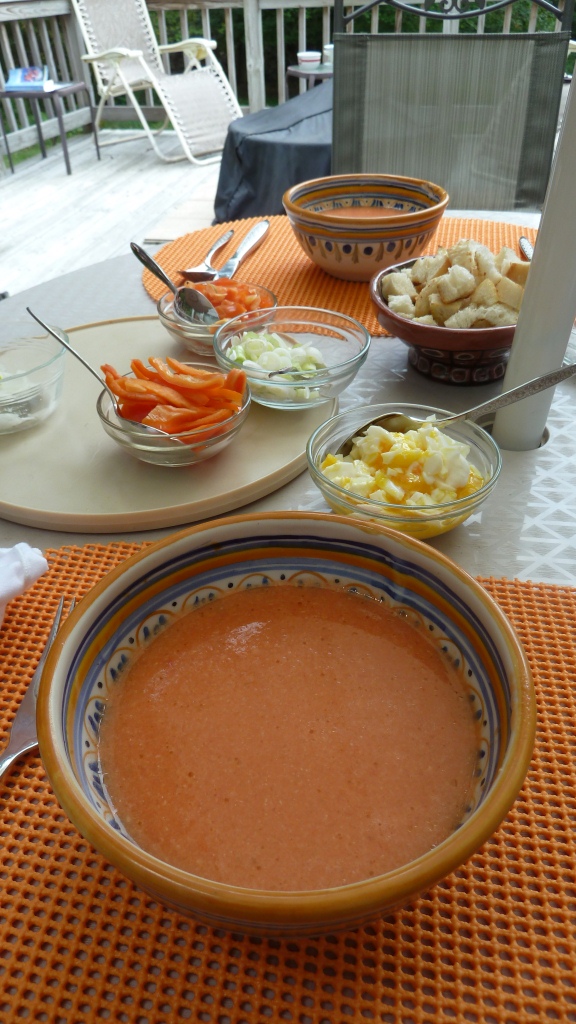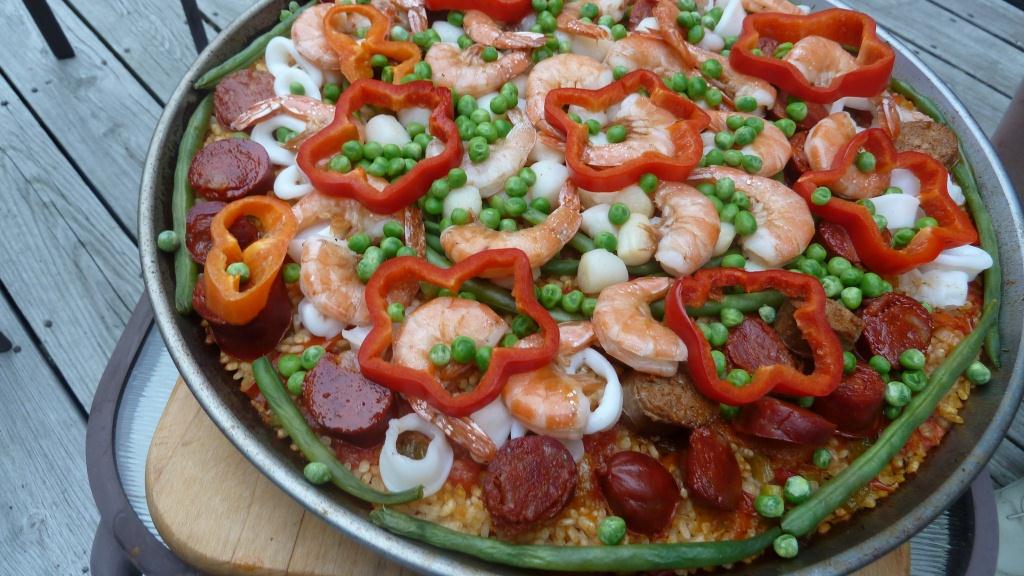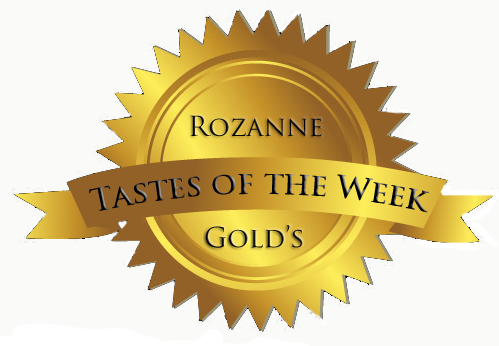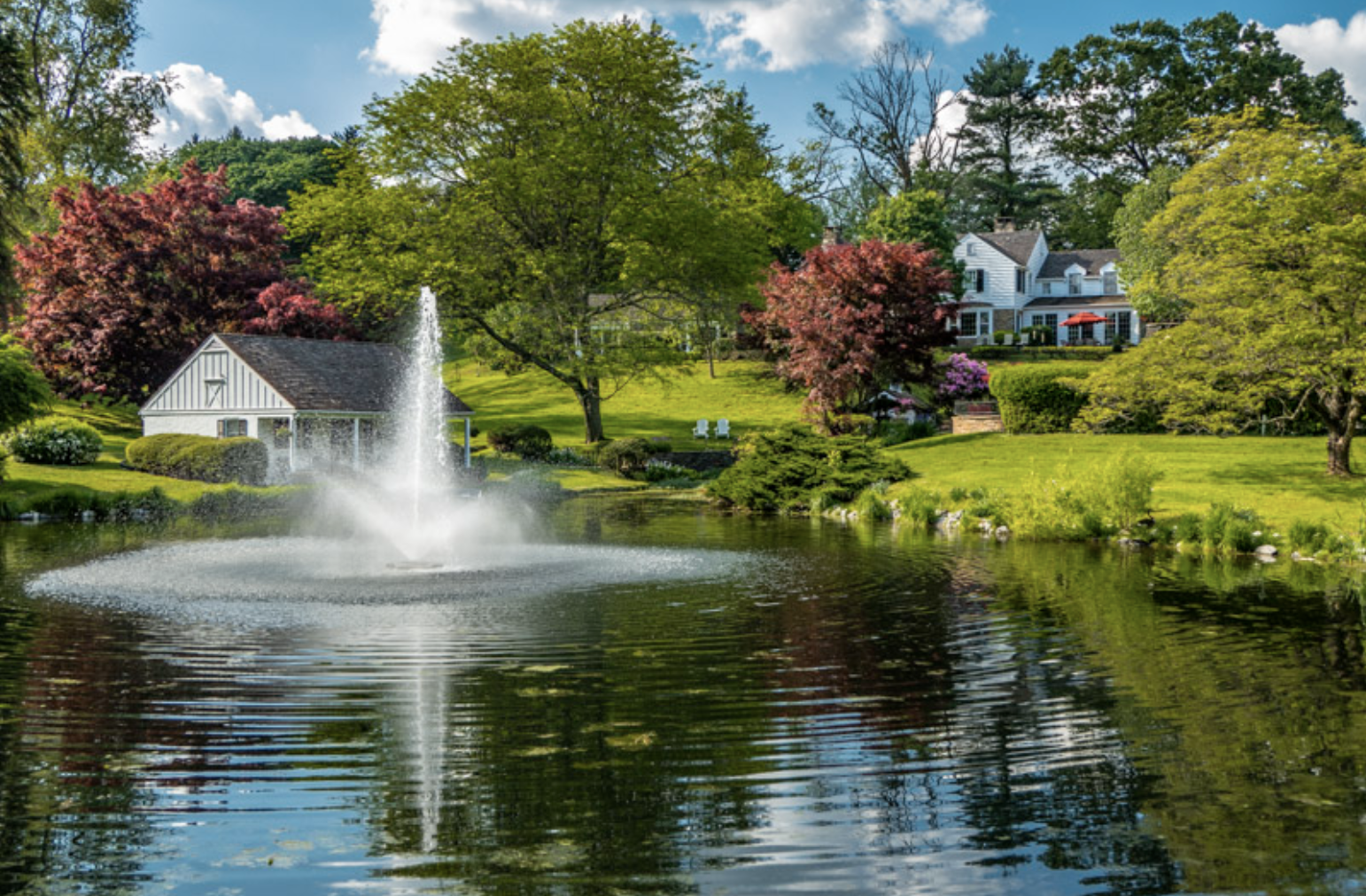Two weeks ago, at the very last minute we cancelled our gorgeously-planned trip to Italy, Florence and northwest Tuscany to be exact. Instead, we landed in Spring Lake, New Jersey, a posh enclave among the Jersey shore’s beaches, the very day we were to have been picked up at the Pisa airport by a man named Luca and whisked to the Hotel Kraft in Firenze, a hotel I stayed in when I was 19. Only blocks from the Ponte Vecchio, with a rooftop restaurant looking onto the Arno River, it was where I first fell in love with the food of Tuscany and the hotel’s handsome assistant manager, Pepe Regoli. And so we pretended.
The memories flooded me as did the torrential rains of Hurricane Henri that would barely escape us as we checked into, alas, not the Hotel Kraft mind you, but into Spring Lake’s pristine Chateau Inn & Suites. Italy would have to wait (for better, post-Covid times). As everyone hunkered down for the impending storm we crazily headed straight to what is considered the most elegant of the Jersey shore towns. Despite the rain and gray skies, the sun found us anyway, long enough to enjoy the beach (and our daily game of scrabble), brunch at Breakers on the Ocean, and a surprisingly very Italian inspired meal, sitting outside under a full moon with pots of blooming hibiscus, a starry night, stone walls, a credible pasta alla vodka, scallops with basil, and a waiter named Tony, at Arugula. Before dinner began, we ran to our car to retrieve one of the wine bottles stored in the trunk – these places are all BYOB, which makes eating incredibly reasonable. A bottle of Sambuca came with the excellent espresso at the end of the night. Earlier that day there were salmon cakes and crab cakes and great clams on the half shell at Spring Lake Café. Was I imagining, but did some of this – deep blue ocean, ancient white sand, long walks, lush greenery, Italianate-villas, and a church fashioned after the Sistine Chapel, feel a bit like…
Next stop: The Inn at Whitewing Farm in the Brandywine Valley, run by the extraordinary owners Lance and Sandy Shortt. For decades we have wanted to visit Longwood Gardens and Winterthur, the magnificent estate of the DuPont family, and the equally impressive Nemours Estate and Gardens owned by another of the DuPont family clan. We first heard about Winterthur, now a museum of American decorative art, from a friend who became a high-end furniture restorer. His adoration of the displays in the 175 rooms of the mansion, viewed by many who took decorative arts and American craftsmanship seriously, was infectious. Due to Covid, however, we were limited to a dozen or so rooms but the visit was well worth it. The grounds are extraordinary, the trees more majestic than most any we’ve seen anywhere, and the adjacent galleries were notable (including a permanent soup tureen exhibit funded by Campbells – but we preferred the simplicity of the tureens we had at home!) The Inn at Whitewing Farm is a gem. There is a beautiful pool, sumptuous home-cooked breakfasts, tennis court, wide expanses of huge, lush greenery, and Adirondack chairs for simply gazing into a gushing geyser in the pond, one that refracts sunlight to allow a rainbow of colors to settle on the water. We stared. We relaxed. We swam and pretended we were in Italy. It wasn’t difficult at all. There were the Italian fountains at Longwood Gardens; outdoor dining behind an old stone barn where we sipped pinot grigio with our burrata and fried green tomatoes, and Montelpuciano with our steamed mussels and semolina bread at The Gables at Chadds Ford.
Before heading off to the wonderful Brandywine River Museum and a tour of N.C. Wyeth’s home and studio, we enjoyed an al fresco breakfast of spinach frittatas, fresh figs and espresso at the Inn. Not quite Italy, but…
Here’s how to do it: Two nights at the Chateau Inn & Suites in Spring Lake (or the Ocean House); dinner at Arugula, breakfast at Breakers on the Ocean, lunch at Spring Lake Café. Two nights at the Inn at Whitewing Farm in West Chester, PA; visits to Longwood Gardens, Winterthur, Nemours Mansion & Gardens, the Brandywine River Museum, dinner at The Gables in Chadds Ford.
But the most unexpected part of this “pretend-Italy” happened today in Northport, Long Island, where we landed at a Tuscan-inspired winery called Del Vino Vineyards, sitting in a vast vine-laden garden, eating truffle ravioli filled with spinach and ricotta, and burrata with arugula, to be washed down by few glasses of a really good super Tuscan red wine ~ “the family’s proprietary blend.” Just didn’t see that coming. Not quite Italy, but…
On the Road to Morocco (and Madrid)
 I hope you are all having a wonderful summer. My husband, daughter and I are off to Morocco and Madrid and will be traveling for two weeks (I hope our house guests enjoy themselves!). We are returning to places we have loved in the past and visiting a dear friend in Morocco whom we haven't seen in 14 years. His family has grown as has ours. It's been a time of rapid growth in the world and I know we will see many changes on our journey. Yet some images remain steadfast. I can already inhale the sweet fragrant mint tea that awaits us in Marrakesh. I look forward to "breaking bread" with our friend's family during Ramadan. Excitement rushes through me as I imagine a slow walk through the Prado; tapas at 11 p.m., and a bit of sultry Flamenco afterwards. It will be a joy to see all of it through the eyes of our 16-year-old daughter. During the next two weeks I will be sharing reviews of two new favorite vegetarian cookbooks, some news from our trip, and who knows what else. In the meantime, here are two recipes from Radically Simple -- with evocative flavors from Morocco and Spain -- meant to whet your appetite on a balmy summer night.
Couscous Salad with Dates & Toasted Almonds
I hope you are all having a wonderful summer. My husband, daughter and I are off to Morocco and Madrid and will be traveling for two weeks (I hope our house guests enjoy themselves!). We are returning to places we have loved in the past and visiting a dear friend in Morocco whom we haven't seen in 14 years. His family has grown as has ours. It's been a time of rapid growth in the world and I know we will see many changes on our journey. Yet some images remain steadfast. I can already inhale the sweet fragrant mint tea that awaits us in Marrakesh. I look forward to "breaking bread" with our friend's family during Ramadan. Excitement rushes through me as I imagine a slow walk through the Prado; tapas at 11 p.m., and a bit of sultry Flamenco afterwards. It will be a joy to see all of it through the eyes of our 16-year-old daughter. During the next two weeks I will be sharing reviews of two new favorite vegetarian cookbooks, some news from our trip, and who knows what else. In the meantime, here are two recipes from Radically Simple -- with evocative flavors from Morocco and Spain -- meant to whet your appetite on a balmy summer night.
Couscous Salad with Dates & Toasted Almonds
I developed this recipe for Bon Appetit magazine, and I'm told it became one of their most popular salads. Quite versatile, it can be part of a mezze offering or a great accompaniment to roast lamb. For best results, do not refrigerate and serve at room temperature.
1/3 cup slivered almonds scant 2 cups couscous 1-1/2 cups cooked (or canned) chickpeas 1/4 cup extra-virgin olive oil 2 scallions, finely chopped, white and green parts 10 large dates, pitted and finely diced 1 teaspoon ground cardamom grated zest and juice of 2 lemons 1/3 cup coarsely chopped cilantro
In a large saucepan, bring 2 cups of salted water to a boil. Lightly toast the almonds in a small skillet over medium heat until fragrant, about 2 minutes. Set aside. Add the couscous to the boiling water and stir. Cover and remove from the heat. Let sit for 4 minutes. Uncover and fluff with a fork. Transfer to a large bowl. Add the almonds, chickpeas (drained and rinsed), olive oil, scallions, dates, cardamom, lemon zest, and 3 tablespoons (or more) lemon juice. Stir in the cilantro, salt and pepper. Serves 6
Avocado Soup with Fino Sherry
If you pre-chill the ingredients for this awesome soup, it can be made in a minute! It has a mesmerizing flavor and velvety texture. If making the soup ahead of time, chill well and add the sherry (and optional garlic) at the very end. More awesome still: crumble blue cheese on top and serve with Marcona almonds.
2 medium-large ripe avocados 3 cups chicken broth, chilled 2 cups buttermilk, chilled 2 tablespoons fino sherry 1 small garlic clove, optional
Cut the avocados in half and remove the pits. Scoop the flesh into a food processor. Add the broth and 1-1/2 cups of the buttermilk. Process until very smooth. Stir in the sherry and garlic, pushed through a press. Add salt and freshly ground black pepper to taste. Ladle into bowls and drizzle each serving with a bit of the remaining buttermilk which will float on top. Serves 4 or 5
El Vero Gazpacho (or Gazpacho with Gerry!)
 To my way of thinking, gazpacho is always lipstick red (chock full of the ripest tomatoes), jade green (Asian-style), or even bluish-purple (my playful take on a fruit soup made with blueberries and ginger.) These can all be found in Radically Simple and they are a fabulous prelude to an end-of-summer meal. But true gazpacho, according to Spanish food-and-wine maven, Gerry Dawes, has a kind of orange-red-coral hue. Offered with a "lazy Susan" of garnishes -- fresh chopped tomatoes, red and green peppers, cucumbers, onion (or scallions -- not authentic), chopped egg, warm croutons, the base of the soup is rather smooth and made textural with these colorful add-ons. Today, in Spain, says Gerry, "it has become a trend to add chopped Iberico ham" to the hit parade of toppings. Over the Labor Day weekend we enjoyed the fruits of Gerry's labor, as he showed us step-by-step how to make gazpacho, then regaled us with an authentic paella laden with shrimp, squid, two kinds of chorizo, rice awash in homemade fish stock, peas, and peppers -- all cooked in a huge paella pan set atop an outdoor grill. The goal (and trick) is to get the bottom of the rice to form a nice caramelized crust (socarrat), that is both desirable and delicious. Gerry did. You should see him in the kitchen: the culinary equivalent of a matador.
To my way of thinking, gazpacho is always lipstick red (chock full of the ripest tomatoes), jade green (Asian-style), or even bluish-purple (my playful take on a fruit soup made with blueberries and ginger.) These can all be found in Radically Simple and they are a fabulous prelude to an end-of-summer meal. But true gazpacho, according to Spanish food-and-wine maven, Gerry Dawes, has a kind of orange-red-coral hue. Offered with a "lazy Susan" of garnishes -- fresh chopped tomatoes, red and green peppers, cucumbers, onion (or scallions -- not authentic), chopped egg, warm croutons, the base of the soup is rather smooth and made textural with these colorful add-ons. Today, in Spain, says Gerry, "it has become a trend to add chopped Iberico ham" to the hit parade of toppings. Over the Labor Day weekend we enjoyed the fruits of Gerry's labor, as he showed us step-by-step how to make gazpacho, then regaled us with an authentic paella laden with shrimp, squid, two kinds of chorizo, rice awash in homemade fish stock, peas, and peppers -- all cooked in a huge paella pan set atop an outdoor grill. The goal (and trick) is to get the bottom of the rice to form a nice caramelized crust (socarrat), that is both desirable and delicious. Gerry did. You should see him in the kitchen: the culinary equivalent of a matador.
 Gerry Dawes was deemed by the late James Michener, to be the rightful heir to scribe the sequel to Michener's Iberia. Known by many to be one of the leading experts on Spain's gastronomic scene -- both past and present -- he is the recipient of Spain's prestigious Premio Nacional de Gastronomia (National Gastronomy Award) in 2003 and is a familiar figure on Spain's restaurant circuit. But as food and wine is part of history and culture, Gerry's vast knowledge of Spain, and his beautiful writing style earned him that opportunity by Michener himself. Gerry, however, is so busy entertaining friends, making gazpacho, and bringing famous chefs to Spain, that the reality of his novel still awaits. Gerry has lived on-and-off in Spain for 30 years and his travel notebooks alone are worth stealing. He was the first American journalist to write about Catalan star chef, Ferran Adria for FoodArts (they are now good friends). According to Michael Batterberry, FoodArt's late beloved publisher and editor, "...That we were the first to introduce American readers to Ferran Adria in 1997 and have ever since continued to bring you a blow-by-blow narrative of Spain's riveting ferment is chiefly due to our Spanish correspondent, Gerry "Mr. Spain" Dawes, the messianic wine and food journalist raised in Southern Illinois and possessor of a self-accumulated doctorate in the Spanish Table." Whew. I couldn't have said it better.
Gerry Dawes was deemed by the late James Michener, to be the rightful heir to scribe the sequel to Michener's Iberia. Known by many to be one of the leading experts on Spain's gastronomic scene -- both past and present -- he is the recipient of Spain's prestigious Premio Nacional de Gastronomia (National Gastronomy Award) in 2003 and is a familiar figure on Spain's restaurant circuit. But as food and wine is part of history and culture, Gerry's vast knowledge of Spain, and his beautiful writing style earned him that opportunity by Michener himself. Gerry, however, is so busy entertaining friends, making gazpacho, and bringing famous chefs to Spain, that the reality of his novel still awaits. Gerry has lived on-and-off in Spain for 30 years and his travel notebooks alone are worth stealing. He was the first American journalist to write about Catalan star chef, Ferran Adria for FoodArts (they are now good friends). According to Michael Batterberry, FoodArt's late beloved publisher and editor, "...That we were the first to introduce American readers to Ferran Adria in 1997 and have ever since continued to bring you a blow-by-blow narrative of Spain's riveting ferment is chiefly due to our Spanish correspondent, Gerry "Mr. Spain" Dawes, the messianic wine and food journalist raised in Southern Illinois and possessor of a self-accumulated doctorate in the Spanish Table." Whew. I couldn't have said it better.
 So, it was Mr. Spain last weekend, who finally taught me the gospel-of-gazpacho. No hot spices (the heat come from the garlic), the proper texture, the requisite color, and the most fabulous taste. I took notes and you will find my approximation below. His is the Gazpacho a la Sevilliana -- taught to him by his "Spanish mother" Maria Franco, the proprietress of Pension Santa Cruz located in the old Jewish quarter of Seville. In the old days, it cost $1.00 a night and an extra .15 cents for a hot shower. Gerry differentiated his Sevillana gazpacho from the more brick-colored, thicker, sauce-like salmorejo gazpachos of Córdoba, which are often served with strips of fried eggplant.
So, it was Mr. Spain last weekend, who finally taught me the gospel-of-gazpacho. No hot spices (the heat come from the garlic), the proper texture, the requisite color, and the most fabulous taste. I took notes and you will find my approximation below. His is the Gazpacho a la Sevilliana -- taught to him by his "Spanish mother" Maria Franco, the proprietress of Pension Santa Cruz located in the old Jewish quarter of Seville. In the old days, it cost $1.00 a night and an extra .15 cents for a hot shower. Gerry differentiated his Sevillana gazpacho from the more brick-colored, thicker, sauce-like salmorejo gazpachos of Córdoba, which are often served with strips of fried eggplant.
If you are ever planning a trip to Spain, you might want to hire Gerry to write your itinerary and fix-you-up with some of Spain's greatest chefs and restaurants, or follow Gerry Dawes's Spain: An Insider's Guide to Spanish Food, Wine, Culture and Travel, on his generous blog. His photography is also award-winning. www.gerrydawesspain.com
Gerry's Gazpacho Gerry says the base of gazpacho is primal -- water, vinegar, garlic and bread.
5 very large ripe tomatoes, cut into wedges 1-1/2 large cucumbers, peeled, seeded and chopped 1/4 cup vinegar (Gerry used 2 tablespoons white wine vinegar, 1 tablespoon sherry vinegar, and 1 tablespoon red wine vinegar) 4 ounces soft baguette, soaked in a bowl of 2 cups water for 20 minutes 1 cup chopped red peppers 1 cup chopped green peppers 1 cup chopped orange peppers 2 large cloves garlic 1/2 cup extra-virgin olive oiil
Process everything in the food processor until smooth, including the water from the soaking bread. Strain into a large bowl. Process the remaining solids until very smooth and add to soup. Chill until very cold. Add salt to taste. Garnish with remaining cucumber, chopped, chopped tomatoes, chopped peppers, chopped egg, chopped onion, and warm croutons. Serves 6 to 8
Tastes of the Week
 August 1 through August 7
A transitional week of tastes and flavors from Rome (bottom up) to Callicoon Center, New York! Fun!
August 1 through August 7
A transitional week of tastes and flavors from Rome (bottom up) to Callicoon Center, New York! Fun!
A wonderful, congenial and perfectly cooked pancake breakfast at the Firehouse in Callicoon Center, New York. We joined what must have been 600 breakfasters, from 7 a.m. till noon, for orange juice, fabulous pancakes cooked by fireman Bill Murray, over-easy eggs, flat round peppery sausages the size of bread-and-butter plates, and good hot coffee. All for 6 bucks. Nice gun raffle, too.
Visiting our daughter in camp near Jeffersonville, New York we fell in love with a cafe and inn called Samba, run by a Brazilian woman and her husband, an actor, director and former captain at the Rainbow Room. Her food is exquisitely comforting and for dinner we enjoyed a fabulous salt cod brandade topped with sunny-side up quail eggs, thick slices of juicy pernil (pork), a wonderful seafood stew made with leeks, cream, clams, mussels and pollock. Dessert was vanilla ice cream with a warm Brazilian sugar-banana caramel. Fab! Steamed broccoli and chopped green cabbage tossed with flaked salt, extra-virgin olive oil and hot pepper flakes. So simple and satisfying -- the vegetables tasted almost sweet. This was dinner at home one night.
Really good warm chocolate chocolate-chip cookies on the plane home from Italy. Added cocoa powder to my favorite chocolate chip cookie recipe this week and voila!
The definitive cacio e pepe (homemade pasta with pecorino romano and lots of cracked pepper) in Rome at the famous Antico Forno Roscioli.
One of the best meals in Italy was at the contemporary l'Antico Arco with a promising young chef who could really make it on the international scene. From Albania, and only 29 years old, Fundim Gjepali respects the cooking of the famous chef Arzak in Spain and himself is cooking pretty sophisticated stuff: fresh mozzarella with bottarga (a new trend in Italy), a warm elixir of ricotta and yogurt topped with asparagus, truffles and poached egg yolk, perfectly cooked risotto made with a local fish, and "meatballs" made from suckling pig.
"Trappizzini" -- made at Pizzeria 00100 on Via Giovanni Branca -- it is a fabulous stuffed bread (better than pizza dough) filled with the best tripe we've ever had (there are a variety of fillings to choose from including chicken cacciatore.) It is a made-up dish -- between a sandwich and a pizza -- and it could become very popular. It's a little hole-in-the wall place that has already been discovered by everyone!
Arrivederci, Roma
 We were awaiting the last of our doppio (double) espressos in our charming room at the Caesar House Residenzia in Rome, conveniently located near Rome’s ancient Forum, Colliseum, and the breathtaking “wedding cake” monument to Vittorio Emanuele, the first King of united Italy. Our two-week journey ended this morning with a quick prima colazione (breakfast) and a trip to the airport. I returned home with my suitcase. It arrived in Naples, 12 days after we did!
As I jokingly said, the day it was lost, that my luggage would be taking a trip of its own. Indeed Alitalia made that happen. It was sent back to Newark, New Jersey, where it remained for five days, then sent to Paris, lost again, and ended up at the Naples airport the very day we were leaving for Rome. Looking for that suitcase became a leitmotif of the trip, as we experienced the frustrations that Italy can bring, but it also brought a sense of liberation, a new handbag, linen pants, and some Italian undergarments into my life!
We were awaiting the last of our doppio (double) espressos in our charming room at the Caesar House Residenzia in Rome, conveniently located near Rome’s ancient Forum, Colliseum, and the breathtaking “wedding cake” monument to Vittorio Emanuele, the first King of united Italy. Our two-week journey ended this morning with a quick prima colazione (breakfast) and a trip to the airport. I returned home with my suitcase. It arrived in Naples, 12 days after we did!
As I jokingly said, the day it was lost, that my luggage would be taking a trip of its own. Indeed Alitalia made that happen. It was sent back to Newark, New Jersey, where it remained for five days, then sent to Paris, lost again, and ended up at the Naples airport the very day we were leaving for Rome. Looking for that suitcase became a leitmotif of the trip, as we experienced the frustrations that Italy can bring, but it also brought a sense of liberation, a new handbag, linen pants, and some Italian undergarments into my life!
Rome was exhilarating, made more so by spending time with Iris Carulli, a dear friend and “guide extraordinaire” to the majesty of Rome. My husband and I spent two days walking, reminiscing (we have been to Rome many times yet not in 20 years), and met Iris in the evening for two splendid meals and then hours of walking the city’s grand piazzas. Iris has lived in Italy now for more than 10 years, and is considered by many to be one of Rome’s best tour guides. You must hire her if you come! Her suggestions were invaluable and her knowledge of art and history made ancient Rome fascinating. Not to mention, present-day Rome! How we enjoyed the contemporary restaurant l’Antico Arco, near the American Academy of Rome (with a strenuous hike at sunset up the Janiculum Hill), the revered trattoria (and bakery) Antico Forno Roscioli, where Sullivan Street Bakery genius, Jim Lahey, came recently to train (the bread in Rome is very good!), and the crowded Piazza Navona, Piazza Venezia, the Pantheon, and Trevi Fountain – all magical at midnight. Most fun was discovering, completely by accident, a Roman trattoria called Agustarello (in an area called Testaccio) where we had the best pasta alla gricia (with guanciale and pecorino), and amazing braised oxtails (darkened with chocolate and full of the requisite, yet invisible, celery). That was lunch.
We enjoyed our visit to MaXXI, the museum of contemporary art, designed by Zaha Hadid, and our tour of the beautiful synagogue of Rome. We even found the ancient bakery which makes “Pizza Ebraica,” or Jewish pizza. Not really pizza at all, but a kind of excessive cookie bar, studded with candied fruit and burnt a bit. No one knows why it is called this, but apparently it has been so for the last 100 years.
Tomorrow morning, I will be eating it slowly, in my own kitchen, accompanied by wonderful memories and a doppio espresso, or two. Arrivederci, Roma.
Tastes of the Week (Naples Edition)
 July 25 to July 31, 2011
The most unusual antipasti I have ever had in my life was at an agriturismo in Padula (near the dazzling monastery Certosa di San Lorenzo.) At “Fattoria Alvaneta” we had “horn of the goat” peppers (corno di capra), which are dried peppers, peperoni cruschi, that were deep-fried (peperoni fritte) until ethereally crispy. About 6 inches long and deep red in color, you are truly amazed at the unexpected texture – like shards of delectable mica. Peperoni cruschi (pronounced crew-ski) are the peppers used for making paprika dolce – which Cecilia uses for making her homemade pancetta. I was fascinated by the sweet, aromatic notes of the peppers and wonder why we don’t think, or know more about Italian paprika.
July 25 to July 31, 2011
The most unusual antipasti I have ever had in my life was at an agriturismo in Padula (near the dazzling monastery Certosa di San Lorenzo.) At “Fattoria Alvaneta” we had “horn of the goat” peppers (corno di capra), which are dried peppers, peperoni cruschi, that were deep-fried (peperoni fritte) until ethereally crispy. About 6 inches long and deep red in color, you are truly amazed at the unexpected texture – like shards of delectable mica. Peperoni cruschi (pronounced crew-ski) are the peppers used for making paprika dolce – which Cecilia uses for making her homemade pancetta. I was fascinated by the sweet, aromatic notes of the peppers and wonder why we don’t think, or know more about Italian paprika.
“Fattoria Alvaneta” was also home to the best and most interesting array of antipasti we’ve encountered anywhere: sauteed escarole with green olives, homemade pancetta and guanciale (made with the wonderful paprika), fresh ricotta cheese with honey and toasted walnuts, the same “dried-and-fried” crispy peppers mixed with scrambled eggs, rospi – balls of fried pizza dough with anchovies (we were surprised how light they were), oil-soaked tomato bruschetta, and an unusual bean and grain soup (made from 13 ingredients!) called Cuccia. What followed? Fresh cavatelli with pepperoni cruschi, and polpette di pane (bread balls! fabulous!) served with a wonderful tomato sauce and a side dish of mashed potatoes, both flavored and colored with paprika.
A last dinner of braised water buffalo at Tenuta Seliano, beautifully cooked and very tasty, alongside a “compote” of braised green peppers and tomatoes. Dessert was our first panna cotta on this trip. It was topped with a fresh raspberry sauce. At breakfast the next morning, we sampled the cakes Cecilia made for us – a chestnut cake made with chestnut flour, ricotta and yellow raisins, and a very interesting carrot cake made with a puree of pears and coarsely shredded lemon peel.
A real Neapolitan espresso (across from the Duomo in Naples) where the “head” or the “crema” is twice as big as the espresso! (My husband bought a great suit next door!)
Lovely pizza at restaurant Europeo di Mattozzi, and excellent fried whitebait and a bean soup made from fresh beans, great olive oil and toast.
Fabulous cheap pasta at restaurant Nennella – one of the real finds of the trip. Paccheri with a light tomato-basil sauce and also paccheri with zucca (pumpkin) and tiny shrimp. The zucca tasted of the shrimp water and was delicious.
Unexpectedly great, at another “worker’s place” called Cucina di Mamma where you can have an entire lunch for 7 euros, we opted instead for the best fresh mozzarella, a salad caprese (made with cherry tomatoes) and a big plate of tender chilled octopus. This was followed by spaghetti with a fresh cherry tomato sauce and a marvelous steamed lobster! About 30 euros with wine and sparkling water.
A wonderful, soulful, beautiful dinner at Taverna dell’Arte. The restaurant and owner Alphonso, were recently featured in John Turturro’s new movie Passione (about the soul, life and music of Naples). Bruschetta with Sicilian pesto (basil and almonds), a dry, pungent cheese from Sicily, polenta fritte, and black olive and cheese stuffed Roma tomatoes for starters. Terrific gnocchi with mussels and squid, and veal meatballs with marsala and mushrooms. The ambiance was lovely and felt authentically Neapolitan. The main course was followed by a “palate cleaner” of a basil and lemon sorbetto, followed by a shot of Rosolio (a wonderful liqueur made from a local apple), and peaches marinated in white wine.
We’ve also been walking 5 hours a day to keep up with all this! Ciao, ciao.



